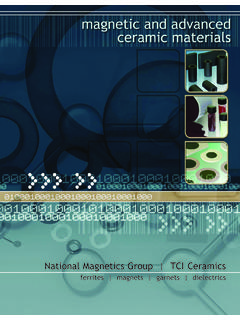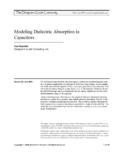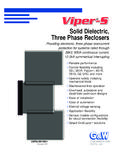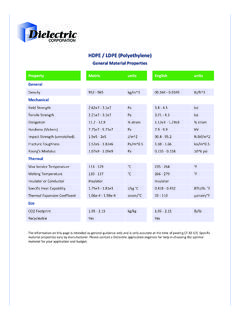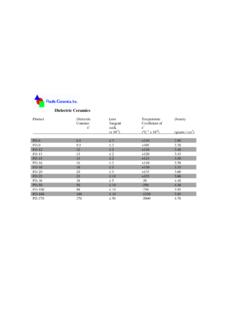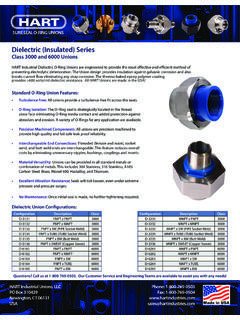Transcription of DIELECTRIC MATERIALS - Magnetics Group
1 TRAK Ceramics, Inc. n18450 Showalter Road, Box 112 n Hagerstown, Maryland 21742 nFax Ceramics, Inc. produces a wide range of lowloss dielectrics commonly used in conjunction with ferritecirculators, isolators, and phase shifters. Some areavailable as substrates for thin and thick film circuitsor for high Q capacitor applications. Dielectricconstants ( ') span from to well above 100. Ceramicswith low DIELECTRIC constants from to 10 often arerequired as supports for our advanced expansion and thermal conductivity for any given DIELECTRIC material cannot be variedsignificantly without altering the favorable electricalproperties.
2 The vast majority of all structural ande l e c t ronic ceramics conduct heat very poorly. However,alumina (Al2O3, '= ) is a modest , it s temperature coefficient of 'which isapproximately +115 ppm/ C can be adjusted to near0 ppm/ C. Magnesia (MgO, '=10) exhibits outstandingthermal conductivity combined with very high thermalexpansion which matches more closely with that ofmetals. Thus, it is made available only as single crystalsubstrates to obtain enhanced with ' ranging from to about 6 are typicallybased on magnesium aluminum silicate and magnesiumsilicate compounds, respectively. Dielectrics with 'inthe 13 to 16 range are based on the compoundsMg2 TiO4and MgTiO3.
3 Several routes can be followedto obtain low loss ceramics with '> 16. CaTi O3s h o w srelatively modest loss but has a high '(150 - 160) anda very large, negative temperature coefficient of '( a b o u t-1600 ppm/ C ). In turn, CaTi O3is chemicallycompatible with both Mg2 TiO4( '~13) and MgTiO3( '~16). Note that the magnesium titanates havemoderately positive temperature coefficients of '. Thus,composite ceramics composed of Mg2Ti O4plus CaTi O3can cover 'from 13 to about 150 at any desired valuewhile composites of MgTi O3plus CaTi O3cover almostthe same range, 16 to about 150. What has escaped both suppliers and users of such products over the yearsis that at some CaTiO3content in both series thet e m p e r a t u re coefficient of 'must traverse from positivet h rough zero before becoming negative.
4 ForMgTiO3/CaTiO3composite ceramics, this occurs at '~20-21. This particular temperature compensatedceramic is now standard for patch antennas and forcoaxial resonator and filter loss ceramics covering 'from about 37 to about100 also can be produced from barium , the low end of the series is the compound,BaTi4O9. Small increases in the TiO2content yieldB a Ti4O9/ B a2Ti9O2 0ceramic composites or pureBa2Ti9O20. However, the 'remains in the 37-39 rangeand temperature coefficient of 'remains very small butslightly negative. The region, '~ 3 9 - 1 0 0 ,is characterizedby ceramics consisting of Ba2Ti9O20plus TiO2. Both 'and temperature coefficient of 'rapidly rise inmagnitude with increasing TiO2( '=100) CompensatedDielectricsThis family of advanced dielectrics is characterized byhigh DIELECTRIC constants that are independent of usefulf re q u e n c y, high Q which is a function of fre q u e n c y, andvery low, but adjustable, temperature coefficients ofresonant fre q u e n c y, 'and capacitance.
5 High permitsminiaturization of substrates, antennas, re s o n a n tcircuits, metal cavities, filters, and capacitors. Drift infrequency due to environmental fluctuations and/or tocircuit heating is effectively eliminated by the smallcoefficients. High Q assures low insertion losses,especially for high power cutting edge of science, technology, andm a n u f a c t u re of these remarkable ceramics has beenadvanced systematically by TCI engineers since the early1 9 7 0 s. Theoretical considerations once suggested thatDIELECTRIC MATERIALSTRAK Ceramics, Inc. n18450 Showalter Road, Box 112 n Hagerstown, Maryland 21742 nFax with small temperature coefficients and highQ simply were not possible if ' was much greater thanabout 20.
6 First, we pushed this frontier to ceramics with 'in the 23 38 range and these have become industrytargets and standards. More recent advances andi m p rovements have demonstrated equivalent or betterp roperties for ceramics in the '=42 46 re s e a rch with worldwide collaborationsd i rected by TCI is focused on new generations of higher 'ceramics without compromising with 'in the 36-46 range are based onBa2Ti9O20or ZrTiO4parent compounds. Tuning of Q,t e m p e r a t u re coefficients, and 'is accomplished usingsubstitutions of Sn4 +, Nb5 +, Zn2 +, Ta5 +, and Mg2 +c o m b i n e dwith lower concentrations of manganese and/orcobalt.
7 High 'ceramics in the 70 90 range, with modest Q,were developed for coaxial resonators, dielectricresonator filters, and substrate applications particularlyfor frequencies below about 2 GHz. More recently,increases in 'to the 100-125 range have been provenwithout drastic reduction in Q. These ceramics consistof solid solutions within the complex series, B a6 - 3 xL n8 + 2 xTi1 8O5 4, where Ln is La3 +, Nd3 +, Sm3 +, and/orGd3+. Substitutions of Sr2+ and Pb2+for Ba2+ and of Bi3+for Ln3+are made to tune DIELECTRIC constants andtemperature Q ceramics typically have 'in the 21-30 rangeand, there f o re, are useful for demanding Q applicationsabove GHz.
8 These MATERIALS are based on solidsolutions of parent compounds that includeBa3Ta2 MgO9, Ba3Ta2 ZnO9, BaZrO3, and , tungsten, manganese, nickel and lithiumsubstitutions are used to tune Q and m p e r a t u re compensated dielectrics with excellent Qbut low '(10-21) are produced as three types ofcomposites. The first ( '=10) is based on alumina (Al2O3)and features modest thermal conductivity and smallthermal expansion. The second is based on MgAl2O4( '=10) which features ease of control over thet e m p e r a t u re coefficient and ease of machining. The lastis a MgTiO3/CaTiO3composite ( '=21) that allows fora size increase or decrease as needed for a development of high 'and high Q dielectrics withnear zero ppm/ C temperature coefficient of ',frequency, or capacitance has been driven largely byempirical studies and practical experience based onsound principles of solid state chemistry.
9 While veryrough approximations are available to predict 'for anycombination of cations and anions in a stable orpostulated configuration at the atomic level, there hasbeen minimal progress in predicting Q and especiallyt e m p e r a t u re coefficients. To complicate matters,intrinsic Q of a crystalline material can be masked byimpurities brought in from raw MATERIALS and/or fromthe processing. Typically, these degrade Q by forminglossy secondary phases and/or by creating lossy re g i o n sassociated with pores and/or grain boundaries in theceramic. TCI engineers, working with experts worldwide,have been demonstrating that high Q clearly dependson exactly how cations and anions are distributed withincrystallites of a polycrystalline material over short andlong distances measured in Angstroms (10 6cm) at theatomic level.
10 Principles have been developed, impro v e d ,and are being tested constantly to derive guidance forfurther advances and improvements in high and Q are proven using theory, practicalprinciples, and experiment, the next major hurdle is totune the temperature coefficients via appropriate cationsubstitutions. Here, there is very little theoretical guidancedespite recent, excellent work treating compoundshaving the so-called perovskite structure ( , CaTi O3,Ba3Ta2 ZnO9, etc). Consequently, tuning is left toexperience and experiment guided by the principlesof crystal chemistry. Altern a t i v e l y, temperaturecoefficients can be tuned by producing ceramiccomposites containing crystalline entities in correctp roportion that have coefficients of opposite sign (withoutdegrading 'and Q).


